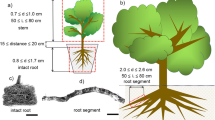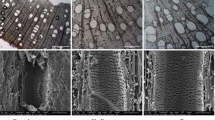Abstract
Plants have efficient water-transporting vascular networks with a self-recovery function from embolism, which causes fatal discontinuity in sap flow. However, the embolism-refilling process in xylem vessel is still unclear. The water-refilling processes in the individual xylem vessels of excised Arabidopsis roots were visualized in this study using synchrotron X-ray micro-imaging technique with high spatial resolution up to 1 μm per pixel and temporal resolution up to 24 fps. In normal continuous water-refilling process, we could observe various flow patterns affected by the morphological structures of the xylem vessels, especially when water passed through perforation plates. A simple criterion based on the variation in dynamic pressure was suggested to evaluate the contribution of individual perforation plates to the water-refilling process. Meanwhile, the water-refilling embolized sections of xylem vessels through radial pathways were also observed. Separated water columns were formed from this discontinuous water-refilling process and the water influx rates through the radial pathways were estimated to be 478 and 928 μm3 s−1. The dynamic behavior of the separated water columns were quantitatively analyzed from the stoppage of volume growth to the translational phase. These water-refilling processes in excised roots of Arabidopsis may shed light on understanding the water refilling in the embolism vessels of intact plants and the interconnectivity of xylem vessel networks in vascular plants.








Similar content being viewed by others
References
Choat B, Cobb AR, Jansen S (2008) Structure and function of bordered pits: new discoveries and impacts on whole-plant hydraulic function. New Phytol 177:608–626
Christman MA, Sperry JS (2010) Single-vessel flow measurements indicate scalariform perforation plates confer higher flow resistance than previously estimated. Plant Cell Environ 33:431–443
Ellerby DJ, Ennos AR (1998) Resistances to fluid flow of model xylem vessels with simple and scalariform perforation plates. J Exp Bot 49:975–985
Garrigues E, Doussan C, Pierret A (2006) Water uptake by plant roots: I—formation and propagation of a water extraction. Plant Soil 283:83–98
Kaufmann I, Schulze-Till T, Schneider HU, Zimmermann U, Jakob P, Wegner LH (2009) Functional repair of embolized vessels in maize roots after temporal drought stress, as demonstrated by magnetic resonance imaging. New Phytol 184:245–256
Kim HK, Lee SJ (2010) Synchrotron X-ray imaging for nondestructive monitoring of sap flow dynamics through xylem vessel elements in rice leaves. New Phytol 188:1085–1098
Lee SJ, Kim Y (2007) In vivo visualization of the water-refilling process in xylem vessels using X-ray micro imaging. Ann Bot 101:595–602
McCully ME (1999) Root xylem embolisms and refilling. Relation to water potentials of soil, roots, and leaves, and osmotic potentials of root xylem sap. Plant Physiol 119:1001–1008
Nardini A, Lo Gullo MA, Salleo S (2011) Refilling embolized xylem conduits: is it a matter of phloem unloading? Plant Sci 180:604–611
Roth A (1996) Water transport in xylem conduits with ring thickenings. Plant Cell Environ 19:622–629
Sano Y, Okamura Y, Utsumi Y (2005) Visualizing water-conduction pathways of living trees: selection of dyes and tissue preparation methods. Tree Physiol 25:269–275
Scheenen TWJ, Vergeldt FJ, Heemskerk AM, Van As H (2007) Intact plant magnetic resonance imaging to study dynamics in long-distance sap flow and flow-conducting surface area. Plant Physiol 144:1157–1165
Schulte PJ, Castle AL (1993) Water flow through vessel perforation plates—a fluid mechanical approach. J Exp Bot 44:1135–1142
Steudle E (2000) Water uptake by plant roots: an integration of views. Plant Soil 226:45–56
Steudle E, Peterson CA (1998) How does water get through roots? J Exp Bot 49:775–788
Vesala T, Holtta T, Peramaki M, Nikinmaa E (2003) Refilling of hydraulically isolated embolized xylem vessel: model calculations. Ann Bot 91:419–428
Zwieniecki MA, Holbrook NM (1998) Diurnal variation in xylem hydraulic conductivity in white ash (Fraxinus americana L.), red maple (Acer rubrum L.) and red spruce (Picea rubens Sarg.). Plant Cell Environ 21:1173–1180
Zwieniecki MA, Holbrook NM (2000) Bordered pit structure and vessel wall surface properties. Implications for embolism repair. Plant Physiol 123:1015–1020
Zwieniecki MA, Holbrook NM (2009) Confronting Maxwell’s demon: biophysics of xylem embolism repair. Trends Plant Sci 14:530–534
Acknowledgments
This work was financially supported by the Creative Research Initiative (Diagnosis of Biofluid Flow Phenomena and Biomimic Research) of the Ministry of Education, Science, and Technology and National Research Foundation of Korea. The X-ray imaging experiments were performed at the 1B2, 7B2, and 6D beamlines of Pohang Accelerator Laboratory (Pohang, Korea).
Author information
Authors and Affiliations
Corresponding author
Electronic supplementary material
Below is the link to the electronic supplementary material.
Supplementary material 1 (MPG 3122 kb)
Supplementary material 2 (MPG 3334 kb)
Rights and permissions
About this article
Cite this article
Lee, S.J., Hwang, B.G. & Kim, H.K. Hydraulic characteristics of water-refilling process in excised roots of Arabidopsis. Planta 238, 307–315 (2013). https://doi.org/10.1007/s00425-013-1889-x
Received:
Accepted:
Published:
Issue Date:
DOI: https://doi.org/10.1007/s00425-013-1889-x




